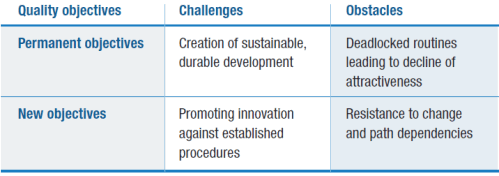Now that the preconditions for management and the technical tools for change and improvement are in place, one might assume that the envisaged change is implemented as planned. Far from it, it still remains to ask if the people in your organisation are ready for change and motivated enough to put the improvement and action plans into practice.
There are still some issues that must be considered to achieve the envisaged change. The challenges and obstacles that may occur in pursuit of different quality objectives are summarised in Table 2.
Table 2. Types of objective and improvement of quality

Source: CEDEFOP.
Permanent or long-lasting quality objectives become tiresome and lose attractiveness in people’s minds. It is difficult to stay motivated over the years to achieve further improvements, which might themselves be blocked by deadlocked routines.
Implementing new innovative objectives is even harder: innovations go hand in hand with abolition of cherished traditions and ingrained customs. This frightens people and they will express their emotions in resistance to change and subtle conflicts. When implementing innovation, the organisation itself must adopt new patterns of action, departing from well-known roads and overcoming path dependencies.
What can be done to ensure readiness for change within your organisation? Two main approaches are at hand: one approach is to improve ability of people in your organisation and the second is to increase their acceptance of change. For an overview, see Figure 12.
Figure 12. Ensuring readiness for change within your institution

Source: CEDEFOP.
Communication with people, providing information on what is intended and what is expected, should help to increase their knowledge and ability to face new demands. Special attention should be paid to those who are acutely affected by the envisaged change and for some individual counselling might be appropriate.
Usually, change and improvement put new and different demands on people and therefore one should ensure that they have the necessary competences, skills and expertise at their command to cope with their new assignments and changing tasks.
Providing opportunities for participation in all stages of quality development is probably the best way to create acceptance of change and compliance towards upcoming new demands. It is a precondition for compliance with quality standards that people feel encouraged and supported not only in their extraordinary efforts for better quality but in their daily activities too.
Finally, encouraging people’s self-esteem and valuing them is another important key to creating readiness for change, as well as promoting commitment and motivation through incentives and compensation for extraordinary efforts towards better quality. Readiness for change is a necessary precondition for any organisation to move towards a culture of quality.
Box 26. Questions for reflection and options for further action
|
|
Please answer the Questions (in the field Comment) and complete the Quiz as well. |
| Questions: | 7 |
| Attempts allowed: | Unlimited |
| Available: | Always |
| Pass rate: | 75 % |
| Backwards navigation: | Allowed |